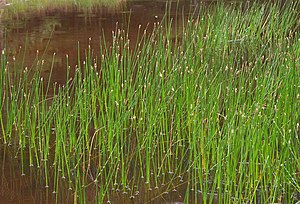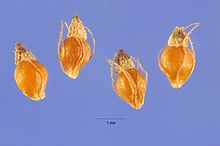Ordinary rush
| Ordinary rush | ||||||||||||
|---|---|---|---|---|---|---|---|---|---|---|---|---|

Common rush ( Eleocharis palustris ) |
||||||||||||
| Systematics | ||||||||||||
|
||||||||||||
| Scientific name | ||||||||||||
| Eleocharis palustris | ||||||||||||
| ( L. ) Roem. & Schult. |
The common swamp rush ( Eleocharis palustris ) is a plant species which, together with other representatives of the genus, forms the widespread species group Eleocharis palustris agg. within the family of Cyperaceae belongs. The richly shaped sour grass grows in wet locations in silting societies on banks, in wet meadows and swamps .
Systematics
The common swamp rush is part of the species group Eleocharis palustris agg. the most widespread species. This group of similar species is taxonomically complex and insufficiently researched due to inconsistent chromosome structures and numbers as well as intraspecial hybridizations . This group also includes the Austrian swamp rush ( Eleocharis austriaca Hayek ), the teat swamp rush ( Eleocharis mamillata Lindb. F. ), The single-skin swamp rush ( Eleocharis uniglumis (Link) Schult. ), Eleocharis macrostachya Britton , Eleocharis erythropoda Steud. , Eleocharis kamtschatica (CAMey.) Kom. And others.
The basionym of the species is Scirpus palustris L. Further synonyms were, for example, Eleocharis intersita Zinserl. or Eleocharis smallii Britton .
The following subspecies and varieties are defined:
- Eleocharis palustris subsp. iranica Kukkonen : It occurs from Egypt and Turkey to Pakistan.
- Small fruited common rush ( Eleocharis palustris subsp. Palustris ): number of chromosomes: 2n = (14-) 16 (-17). It occurs from the temperate zones of the northern hemisphere to the Himalayas.
- Eleocharis palustris var. Vigens L.H.Bailey : Chromosome number: 2n = 36. It occurs in North America.
- Large-fruited common rush ( Eleocharis palustris subsp. Waltersii Bureš & Danihelka , Syn .: Eleocharis palustris subsp. Vulgaris Walters , Eleocharis vulgaris Á.Löve & D.Löve ): number of chromosomes: 2n = (33-) 38-39 (-40). It occurs from Europe to Cyprus.
Distribution and location
The distribution area of the common swamp rush includes the temperate to cold-temperate latitudes of the northern hemisphere.
The plants predominantly colonize wet locations in silting areas of bodies of water in wet meadows and in swamps on flooded to occasionally dry, nutrient-rich and mostly base-rich, humus-rich sandy and silty soils. They are pioneers of root creeping and often form pure stands in suitable locations, which in plant sociology is called swamp rush reeds (Eleocharitetum palustris). Overall, the species occurs in societies of the order Phragmitetalia. The plants also grow in salt-influenced ( brackish ) locations near the coast or inland.
features
Growth and life form
The evergreen, perennial plants reach heights of growth between 10 and 100 centimeters. The marsh plants ( helophytes ) and hemicryptophytes with renewal buds near the base form dense mats with long, powerful, monopodial and unbranched rhizomes that creep underground . The rhizomes measure 1.5 to 4.5 millimeters in diameter. The internodes reach between 10 and 35 centimeters in length. The membranous, sometimes fibrous lower leaves are between 6 and 20 millimeters long.
Stems and leaves
The leafless, rush-like, grass- to dark-green stalks grow rigidly upright. They are round to slightly flattened, smooth, firm and hardly compressible, and when dry they have little furrowing with 8 to 30 flat ridges. They are filled with a spongy pith and are 30 to 115 centimeters long and 0.5 to 1.5 millimeters wide. The leaf-sheaths without spreading are brown or dark red and shiny. The lower ones are rough or obsolete, closed or split.
Flowers and fruits
The inflorescence consists of a terminal, oblong-cylindrical and pointed 5 to 30 millimeters long, 20 to 70 flowered spikelets . The husks are oblong-ovate, blunt to slightly pointed. They are pale or brown with a white-yellowish skin edge and a green median nerve. They reach 3 to 5 millimeters in length. The bottom husk covers about half of the stem. Perigone bristles are absent or 3 to 5 exist. These are rough on the back and slightly shorter than the fruit. There are three dark yellow stamens and two to three stigmas . The styles are constricted at the base and usually a little higher than wide. The yellow, brown to black achenes , a special form of the nut fruit, are lenticular in cross-section and up to 1.8 millimeters long.
Distinguishing features of the subspecies and varieties
The sub-species and varieties differ mainly in the number of individual flowers of spikelets, the shape and size of the straws, the spikelets, middle husks and fruits as well as the size of the stomata (stomata).
- The stalks of the small-fruited common marsh rush are 1.5 to 2.5 millimeters in diameter and up to 1 meter long with 12 to 15 nerves. The spikelets are 40 to 70 flowered. The middle husks are 2.7 to 3.5 millimeters long and the fruit measures 1.2 to 1.4 millimeters in length. The length of the stomata is between 39 and 48 µm.
- The spikelets of the large-fruited swamp rush, on the other hand, are 20 to 40-flowered; the middle husks reach 3.5 to 4.5 millimeters, the fruit 1.5 to 2 millimeters in length. The stomata are comparatively large at 54 to 70 µm.
- The fruits of the North American Eleocharis palustris var. Vigens, which grow to about 1 meter high, reach between 1.6 and 2 millimeters in length. The middle husks are between 3.5 and 4.5 millimeters long. With 52 to 65 µm, the stomata are somewhat smaller than those of the large-fruited common rush.
- The culms of Eleocharis palustris subsp. iranica reach a diameter of 1.5 to 2 millimeters and are deeply grooved with 10 to 16 distinct nerves. The husks reach between 2.5 and 3 millimeters in length; the fruit measures 1.3 to 1.5 × 0.9 to 1.1 millimeters.
Phenotypes
The location and environmental conditions influence the appearance of the plants ( phenotype ). In the water, however, rougher and stronger plants grow from it. These types are known as the "crassa" phenotype. More delicately built plants develop in sparsely vegetated habitats such as swamps and wet meadows that are not permanently flooded . They are described as the "meadow" or "grassland" phenotype.
Biology and ecology
The common swamp rush reproduces mainly vegetatively via a creeping, far-reaching and strongly networked rhizome system of the individual clones ( ramets ). In this way it can form dense, pure stands with diameters of up to 2 meters. The plant sprouts from near-ground renewal buds in spring; the main growing season is in summer. The generative reproduction is of less importance. The flowering period begins in spring and extends from May to August, sometimes until early autumn. The wind-flowering plants do not produce fruit in large numbers until they are two to three years old between July and August. Their ability to develop is low, because only a few reach maturity. The diaspores spread via water, by adhering to the fur and plumage of animals and by the wind.
The common swamp rush is a half-light to full-light plant and therefore only tolerates little shade. Their places of growth are therefore located in silted areas on bodies of water upstream of a reed bed or sedge belt or are located in sufficiently sun-drenched obstacles in wet meadows or swamps, which they can quickly colonize as pioneers. As an alternating water indicator, the plant sometimes thrives in water depths of up to 1 meter, on permanently flooded and temporarily dry locations, with a water level a maximum of 30 centimeters below the surface. It tolerates a lack of oxygen in the root area and grows on fine sandy to muddy, nutrient-rich soils with a pH tolerance range of 4 to 8.
The seeds, roots and shoots are an important source of food, especially for water birds. For small mammals, on the other hand, the plant is of less value as food. Furthermore, the stocks of the common marsh rush serve as a place to hide or breed for many animals. Especially for dragonfly larvae and other aquatic insects, which leave the water for the last moult to become an adult, the stalks of the swamp rushes, on which they can crawl, are important.
Sources and further information
The information in this article is taken from the sources given under Literature and Web Links, and is based on the following individual references:
Individual evidence
- ^ According to Germplasm Resources Information Network (GRIN) , accessed June 22, 2007
- ↑ a b c d e according to R. Govaerts (2004): World Checklist of Monocotyledons Database in ACCESS: 1-54382. and L. Boulos (2005). Flora of Egypt 4: 1-617. Al Hadara Publishing, Cairo. The Board of Trustees of the Royal Botanic Gardens, Kew ( Memento of the original dated September 29, 2007 in the Internet Archive ) Info: The archive link was inserted automatically and has not yet been checked. Please check the original and archive link according to the instructions and then remove this notice. , last accessed October 27, 2016
- ^ Erich Oberdorfer : Plant-sociological excursion flora for Germany and neighboring areas . With the collaboration of Angelika Schwabe and Theo Müller. 8th, heavily revised and expanded edition. Eugen Ulmer, Stuttgart (Hohenheim) 2001, ISBN 3-8001-3131-5 , pp. 164 .
literature
- Henning Haeupler , Thomas Muer: picture atlas of the fern and flowering plants of Germany (= the fern and flowering plants of Germany. Volume 2). Published by the Federal Agency for Nature Conservation. Ulmer, Stuttgart 2000, ISBN 3-8001-3364-4 .
- J. Grau, BP Kremer, BM Möseler, G. Rambold & D. Triebel: Gräser , Mosaik-Verlag, Munich 1996, ISBN 3-576-10702-9
- Heinz Ellenberg , HE Weber, R. Düll, V. Wirth, W. Werner & D. Paulißen: Pointer values of plants in Central Europe. Scripta Geobotanica 18, Verlag Erich Goltze, 1992. ISBN 3-88452-518-2
Web links
- Ordinary rush. In: FloraWeb.de.
- Ordinary rush . In: BiolFlor, the database of biological-ecological characteristics of the flora of Germany.
- Profile and distribution map for Bavaria . In: Botanical Information Hub of Bavaria .
- Thomas Meyer: Data sheet with identification key and photos at Flora-de: Flora von Deutschland (old name of the website: Flowers in Swabia )
- Flora of North America , accessed June 22
- Flora of Pakistan , accessed June 22
- Hauser, A. Scott. 2006: Eleocharis palustris . In: Fire Effects Information System, http://www.fs.fed.us/database/feis/plants/graminoid/elepal/all.html US Department of Agriculture, Forest Service, Rocky Mountain Research Station, Fire Sciences Laboratory (Producer ). Retrieved June 22, 2007
- Eleocharis palustris inthe IUCN 2013 Red List of Threatened Species . Listed by: Lansdown, RV, 2012. Retrieved April 12, 2014.
Distribution maps
- Distribution map for Germany. In: Floraweb .
- Eleocharis palustris (L.) Roem. & Schult., Map for distribution in Switzerland In: Info Flora , the national data and information center for Swiss flora .
- Area map of Hultén for worldwide distribution according to Den virtuella flora
- Distribution in North America to Flora of North America



